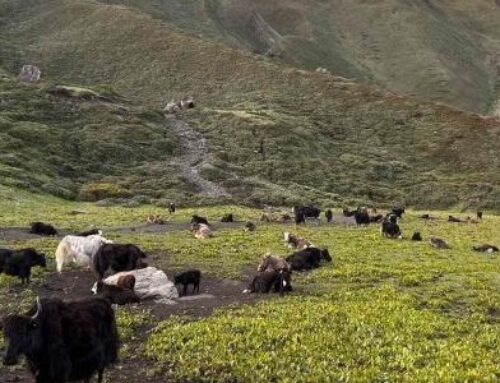
Dolpa District, Nepal – Prime snow leopard habitat – Photo: Tshiring Lhamu Lama
In late 2021, a Foxlight nighttime predator deterrent pilot program was launched in the Dolpa District of Nepal by Conservancy partner Tshiring Lhamu Lama in response to a large depredation incident that occurred earlier in the year — 52 livestock animals (sheep and goats) that were being kept together in a corral were attacked and killed by a snow leopard.

Livestock corral Dolpo District, Nepal – Photo: Tshiring Lhamu Lama
Depredation events usually occur during the months of December through April in this region, which coincides with the breeding season of the snow leopard. It’s also a time when winter weather forces both livestock and predators to lower elevations, and domestic sheep and goats are more often kept in a corral, making them easy prey for predators. Large depredation events do not occur frequently but do happen when snow leopards are triggered by the movement of many animals being held together in a corral. But whether it’s one animal or many, the loss of livestock can be economically devastating.

Meeting with herders – Photo: Tshiring Lhamu Lama
As the snow leopard is considered a sacred species by members of the local communities, its cultural value is equal to that of its importance to the stability of the high mountain ecosystem. This makes finding solutions to conflict between people and this apex predator imperative. With this in mind, Tshiring met with local community members of Koma Village where 20 of the 34 households are herders.

Koma Village, Nepal – Photo: Tshiring Lhamu Lama
Guard dogs are kept by the herders, but snow leopards don’t seem to be bothered by them. The consensus of the herders was that two additional methods of predator deterrence would be effective – installing roofs over traditional corrals and the implementation of lights within the corrals.

Setting up Foxlights around a traditional livestock corral – Photo: Tshiring Lhamu Lama
One Foxlight together with a collapsible pole was distributed to each of the herders to use within their individual corrals. Instruction was provided on the function and use of the Foxlight. Powered by a solar-charged battery and activated by darkness, the random intermittent flashing colored lights can be seen up to kilometer away and have proven to be successful at keeping both snow leopards and wolves away from livestock.

Herders from the Koma Village working with FoxLights – Photo: Tshiring Lhamu Lama





